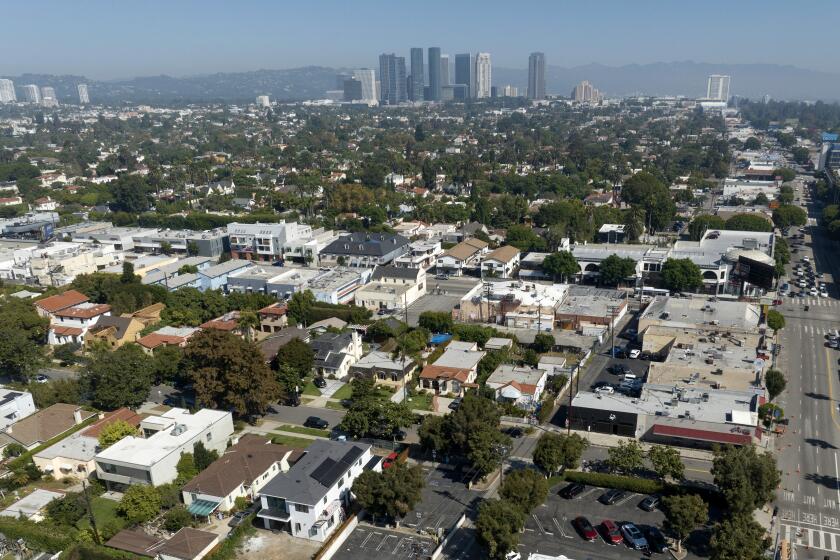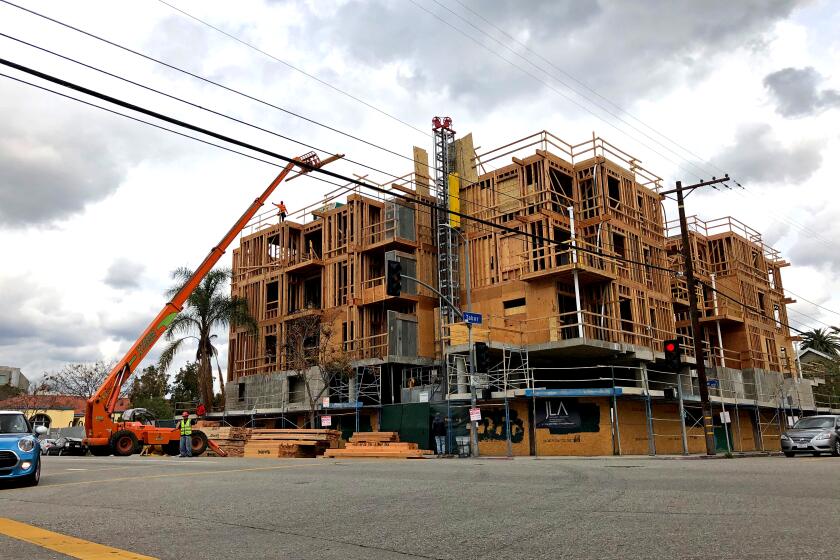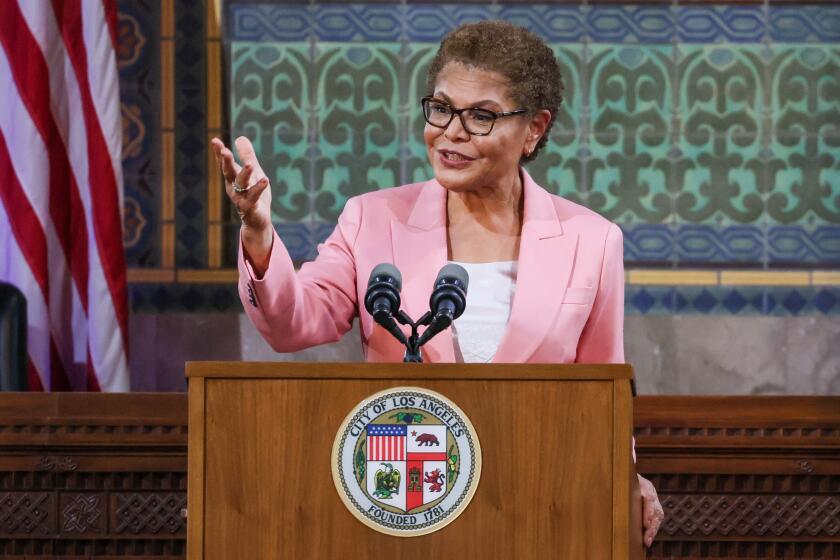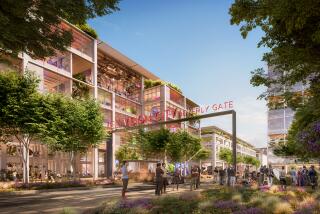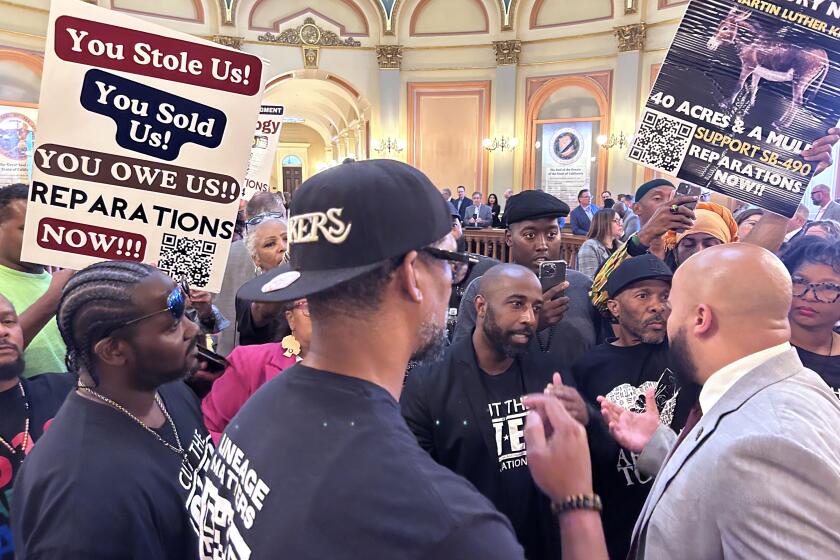Affordable housing in the San Fernando Valley advances despite opposition from Bass, City Council

- Share via
- Four low- and moderate-income apartment buildings on land zoned for single-family homes in the San Fernando Valley are advancing despite the opposition of Mayor Karen Bass and most of the City Council.
- In June 2023, Bass changed her signature executive order on speeding construction of affordable housing to block proposals on single-family zoned sites after neighborhood pushback.
- Legal challenges cleared the way for approval for some developments submitted before Bass revised her order.
By summer 2023, developers had pitched building nearly 2,400 new apartments for low- and moderate-income residents in the San Fernando Valley, where little such housing exists compared with much of Los Angeles.
The plans would not require public subsidy, unusual for low-income housing, and were proposed under Mayor Karen Bass’ signature initiative to promote growth at prices more Angelenos could afford.
Eighteen months later, the majority of the projects have been abandoned, and none have broken ground. Only now, after bruising battles in City Hall and the courtroom, are four of the developments — totaling one-third of the units originally proposed — moving forward. It’s happening against the wishes of Bass and most of the City Council.
These affordable housing projects have faced trouble because they touched one of the third rails of Los Angeles politics. They are proposed on land otherwise reserved for single-family homes.
With a key vote coming on a bid to rezone Los Angeles to add 250,000 more homes, city officials released a long-awaited report on the history of exclusionary zoning.
The development plans attracted scores of angry homeowners upset about traffic, parking and disruption of the character of their communities. Opponents contend that the developers seized a loophole in the mayor’s initiative to put apartments where they were never intended. Other affordable housing projects in the Valley on sites where multifamily developments typically are allowed are advancing without the same pushback.
“The reality of these [projects] was that the impact was disproportionate,” said City Councilmember Bob Blumenfield. “It wasn’t by design. It was by opportunism.”
But for those who supported allowing the projects to move forward, the resistance calls into question the city’s commitment to solving its affordable housing crisis.
“I feel like Los Angeles is a city where politicians are encouraged to run to stop things from happening, where stopping projects and stopping growth is prized as a political asset here,” said City Councilmember Nithya Raman, who chairs the council’s housing and homelessness committee. “I think we need to change that culture. We have to move to being a city that says yes to housing to preserve the city’s future.”
Within a week of taking office in December 2022, Bass signed an order, Executive Directive 1, to eliminate city zoning hearings, appeals, environmental reviews and other permitting hurdles for 100% affordable housing developments so they could be built faster. The program proved popular, with nearly 24,000 units approved for construction, according to the city planning department.
The mayor’s order said nothing either way about the eligibility of single-family-home parcels. Some developers determined that they could combine Executive Directive 1 with state laws designed to expedite housing construction and apply the rules to various single-family-home sites in the Valley. Ten such projects submitted at least preliminary plans to the city, the largest of which was a 611-unit apartment complex in Woodland Hills near the L.A. River.
As the development plans became known, homeowner groups began pushing back. In June 2023, Bass revised Executive Directive 1 to say that properties zoned for single-family homes were not allowed, blocking new projects from going forward.
L.A. City Council asks city attorney to draft an ordinance to boost housing development in existing multifamily areas while leaving single-family communities largely untouched.
The change left the fate of the 10 projects already on the books up in the air, kicking off more than a year of intense politicking and legal fights.
The disputes overlapped with other battles in Los Angeles about affordable housing in single-family-home neighborhoods. Nearly three-quarters of L.A.’s residentially zoned land, including its most affluent areas, is set aside for single-family homes. As part of state-mandated rezoning plans, some social justice and housing groups wanted the city to allow low-income housing to integrate those communities and ease displacement pressures elsewhere. But homeowner organizations fought hard against the proposal, contending that out-of-scale development would overwhelm their neighborhoods, especially since state laws already allow accessory dwelling units on most parcels. Bass and the council sided with the neighborhood groups.
The city planning department had deemed some of the Valley Executive Directive 1 proposals eligible under the mayor’s order before reversing course once the directive was changed. Developers appealed those decisions to the City Council. The state Department of Housing and Community Development urged the projects’ approval, stating in multiple letters to the City Council that the permitting process was locked in when they were submitted.
The first project up for debate was a 200-unit proposal in Sherman Oaks, Raman’s district. She argued that the city should follow the state’s guidance and the development should get to move forward. Her colleagues voted with her.
Less than three weeks later, a second project, 360 units in Winnekta, came before the council. Blumenfield, who represents the area, contended that Bass’ order never meant to allow apartments on single-family-home sites so it should be rejected. His colleagues voted with him. Two subsequent projects, another in Blumenfield’s district in Reseda and one in Councilmember Imelda Padilla’s in Sun Valley, were similarly turned down. The remaining half-dozen proposals, including the one in Woodland Hills, were discarded.
Lawsuits came next. YIMBY Law, a statewide nonprofit that sues local governments that deny housing, filed suit against the city of Los Angeles in L.A. County Superior Court on behalf of the trio of projects that were rejected. A community group, the Ethel Avenue Neighborhood Assn., sued the city over the one that was approved.
Decisions about housing developments shouldn’t be based on the wishes of individual council members but on what the city’s rules say when projects are submitted, said Sonja Trauss, YIMBY Law’s executive director.
“They broke their own law,” Trauss said.
In court, city attorneys contended that Bass’ revised order merely clarified that multifamily projects were prohibited on single-family-home parcels and therefore the denials were proper. Three separate judges rejected that argument and required the city to approve the projects.
“There is no reason to believe the substantive change enacted by Amended ED 1 was secretly and silently lurking in original ED 1’s unambiguous language,” Judge Curtis Kin wrote in a December 2024 decision on the Reseda project.
Bass put new restrictions on her plan to speed up the approval of affordable housing, taking out properties that are in historic districts, hillsides with high fire risk and other areas.
This month, the Sherman Oaks case settled, with the developer agreeing to lower the building’s height from seven stories to six by putting one level of parking underground. An attorney representing the neighborhood group declined to comment and Leon Benrimon, an official with developer Bedrock Property Group, could not be reached for comment.
None of the four projects now cleared for construction sit in the middle of subdivisions, though some are more out of scale with their surroundings than others. Single-family homes dominate the blocks where the Sherman Oaks and six-story Reseda projects are planned. The Sherman Oaks site is next to a school and near two boulevards; the Reseda site is on a four-lane avenue. The seven-story Winnetka project would fit in more with nearby development, which includes an existing apartment complex next door and a gas station on the corner.
In Sun Valley, developer and architect Jeff Zbikowski wants to build 78 apartments with studio, one- and two-bedroom units in a three-story complex. He said his proposal is sensitive to the community, noting that he’s offering more parking than required and that another apartment building neighbors the site.
The income restrictions for prospective tenants and rent limits scale by household size. A single person could earn no more than $77,600 and rent a studio for $1,942. A couple could together make up to $88,720 and rent a one-bedroom for $2,080.
“The city and the state of California have this crazy housing shortage,” Zbikowski said. “There’s this missing middle [of housing] that’s been underserved for years and years.”
For some neighbors, the proposal remains an unwelcome incursion. Norma O. Chávez, president of the Sun Valley Area Neighborhood Council, said the city should preserve single-family-home areas to keep them free from congestion and limit change to the community’s makeup.
“When it’s single-family residences, you get to know your neighbors and your neighbors are proud of their community,” Chávez said. “It’s more maintained.”
Adding apartments to the street, Chávez continued, means “there’s a lot more people and you don’t know where they’re coming from.”
Bass’ office did not respond to a list of questions from The Times. In prior comments, the mayor has emphasized that she supports affordable housing across the city and that her executive order has cleared the way for tens of thousands of new homes.
More to Read
Sign up for Essential California
The most important California stories and recommendations in your inbox every morning.
You may occasionally receive promotional content from the Los Angeles Times.

